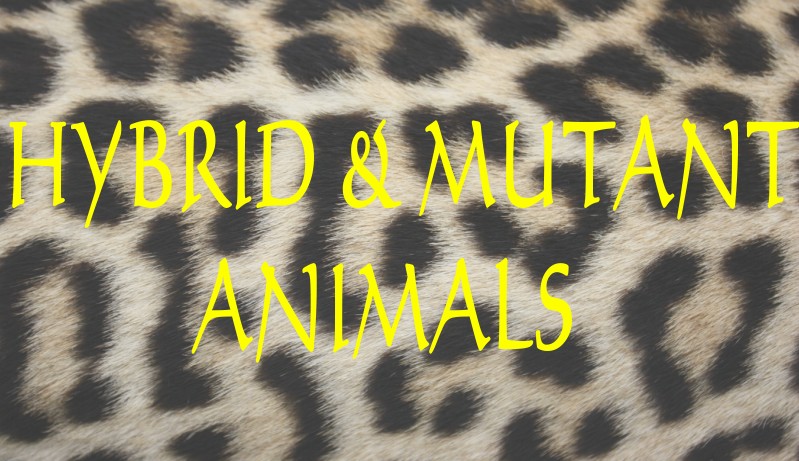

CARL HAGENBECK -BREEDER OF HYBRIDS
Karl Hagenbeck Snr, (1810–1887), a Hamburg fishmonger, founded a wild-animal import business in 1848. In 1863, he opened a menagerie near Hamburg's harbour. In 1866 Carl Hagenbeck Jnr (1844–1913) became its manager. The first Hagenbeck Tierpark was set up on a nearby site in 1874 and, under Hagenbeck Jnr, became the world's premier wild-animal dealership. In 1896, Hagenbeck pioneered the "fenceless zoo", using ditches to confine the exhibits. Performing wild animals remained a major attraction, but were trained through kindness rather than fear. In 1907, the Tierpark Hagenbeck opened at its present location in the Stellingen, Hamburg. Though destroyed during air-raids in WWII, it was rebuilt.
Karl Hagenbeck was born on June 10, 1844, to Claus Gottfried Karl Hagenbeck (1810–1887), a fishmonger who ran a side business buying, displaying and selling exotic animals. Hagenbeck Snr founded his wild-animal import business in 1848, and in 1863, he opened a menagerie near Hamburg's harbour. When Hagenbeck Jnr was 14, his father gahouse them. Hagenbeck left his home in Hamburg to accompany hunters and explorers on trips to jungle regions and snow-clad mountains. He captured animals in nearly every continent in the world. For animal traders, the huge profits made the risks and the death of a proportion of their captives worthwhile. European aristocrats were building zoological gardens and private menageries, and needed exotic animals to stock them. During his first 20 years of business, he sold?at least a thousand lions, three to four hundred tigers, six to seven hundred leopards, a thousand bears of different varieties, around eight hundred hyenas, around three hundred elephants, seventeen Indian rhinos and nine African rhinos, one hundred and fifty giraffes,?and six hundred antelopes of various species.
By the mid-1870s, the market in exotic animals was swamped, so Hagenbeck turned to exhibiting people. In 1874, he decided to exhibit Sami people (then known as "Laplanders") as "purely natural" populations, with their tents, weapons, sleds, along with 30 reindeer. In 1875, he began to exhibit his animals in all the large cities of Europe as well as in the United States. The "family of Laplanders" proved a hit, so in 1876 Hagenbeck ordered "a number of really interesting natives" (Nubians) from the Egyptian Sudan, along with some wild beasts. The Nubian exhibit was very successful in Europe, touring Paris, London, and Berlin in 1877 and 1878. In 1880, his agent Johan Adrian Jacobsen recruited a group of eight Labrador Inuit who were exhibited in Hamburg, Berlin, Prague, Frankfurt, Darmstadt, Krefeld and Paris. One of group, Abraham Ulrikab, kept a diary during his travels in Europe. Tragically, all eight Inuit were killed by smallpox. Hagenbeck's exhibitions of "savages in a natural state," may have inspired Albert Geoffroy Saint-Hilaire's "human zoo" exhibitions in Paris's Jardin d'acclimatation in 1877, when Nubians and Greenland Inuits were exhibited.
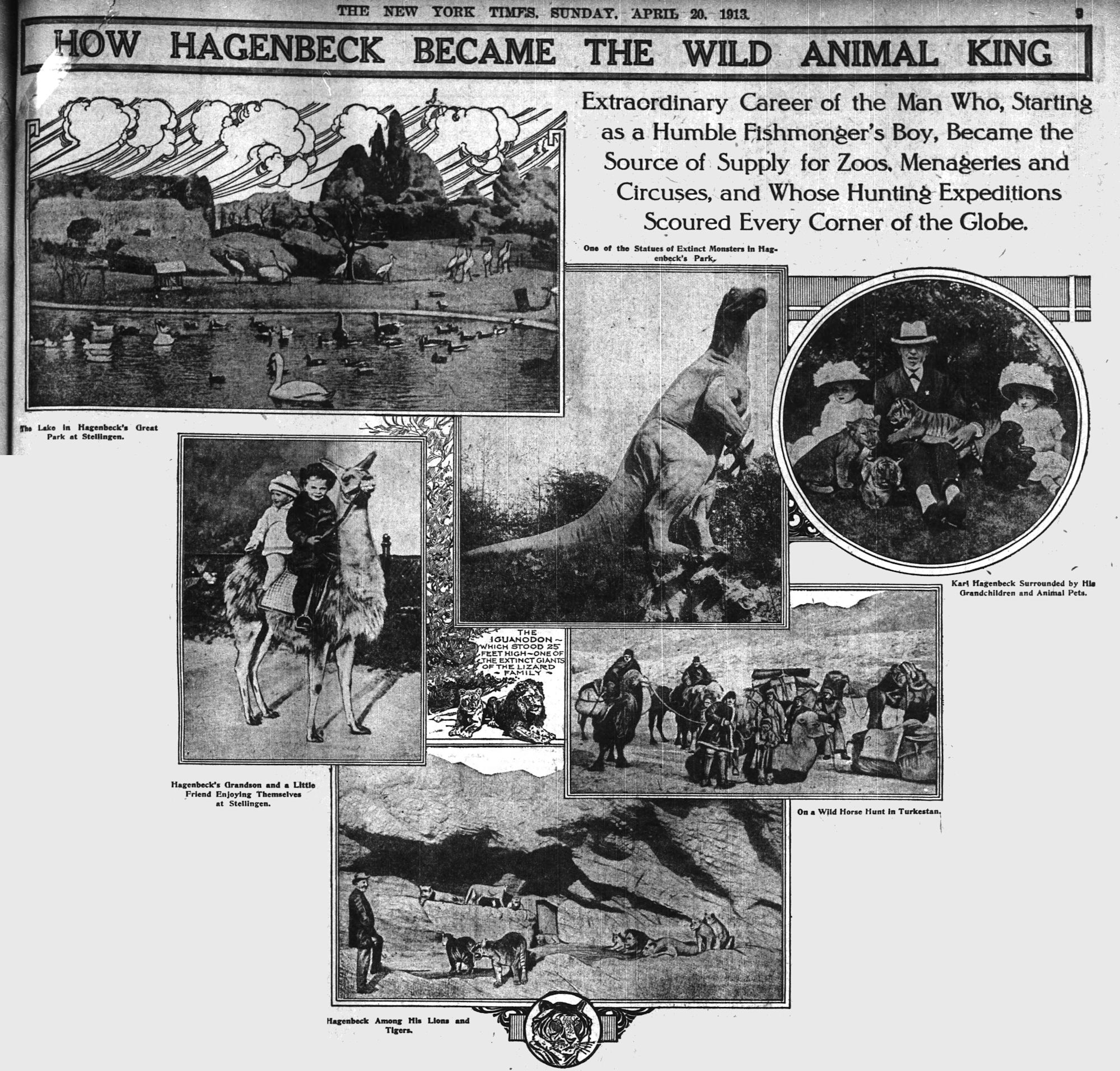
The natives, though a curiosity, were just not savage or freakish enough. Though Hagenbeck paid lip service to ideas about anthropology and education, his people shows were mainly entertainment. By the end of the 1880s, he had returned to animals and revolutionised methods of training them. Abandoning the "old, cruel methods" of training through punishment, he trained animals to perform using a system of rewards. Hagenbeck trained animals for his circuses at the World's Columbian Exposition in Chicago, Illinois, in 1893, and the Louisiana Purchase Exposition in St. Louis in 1904, where his trained animals were one of the most popular attractions. In 1900 he crossbred a female lion with a Bengal tiger and (according to some accounts) sold one tigon to the Portuguese zoologist Bisiano Mazinho. Hagenbeck's trained animals also performed at amusement parks in New York City's Coney Island prior to 1914.
Hagenbeck was one of the first Europeans to describe a creature that came to be known as Mokele-mbembe. In his book ‘Beasts and Men' he claimed to have received reports of "a huge monster, half elephant, half dragon" inhabiting the interior of Rhodesia. He thought the animal was some kind of dinosaur similar to a brontosaurus and unsuccessfully searched for it. This made headlines in newspapers around the world, helping to launch the legend of Mokele Mbembe.
By the beginning of the 20th century, the ethics of making animals perform tricks were increasingly questioned and criticised. Hagenbeck sold his circus and concentrated on what was to be his final great project - a humane animal park where animals could roam freely in natural surroundings, without bars. Despite the existence of the Zoological Garden of Hamburg, Hagenbeck opened his great zoo, the Tierpark Hagenbeck at Stellingen, near Hamburg in 1907. He laid it out as a series of outdoor panoramas, using moats to separate the animals. Visitors could either view the animals from a distance or wander among them, and were even permitted to feed some of them. In 1909-1910 he supervised the building of the Giardino Zoologico in Rome.
Hagenbeck died on 14th April, 1913. The attending physician gave the cause of death as slowly-working snake venom (possible from a boomslang). Hagenbeck had been bitten years earlier and the venom eventually caused his liver to fail. In a tribute to him, the New York Times published the following article on 20th April, 1913, a day after publishing the death notice.
HOW HAGENBECK BECAME THE WILD ANIMAL KING. THE EXTRAORDINARY CAREER OF THE MAN WHO, STARTING AS A HUMBLE FISHMONGER'S BOY, BECAME THE SOURCE OF SUPPLY FOR ZOOS, MENAGERIES AND CIRCUSES, AND WHOSE HUNTING EXPEDITIONS SCOURED EVERY CORNER OF THE GLOBE..
Fifty-five years ago a man who had been most of his life a fishmonger in Hamburg, but who had suddenly branched out, in a small way, as an exhibitor of wild animals, summoned his fourteen-year-old son and said to him: "Karl, the time has come for you to decide whether you will be a fishmonger or a dealer in wild beasts. I advise you to be a fishmonger. It is far less precarious. Which do you choose?"
"Wild beasts," said Karl. The father acquiesced. Within a year the boy, not quite fifteen, was practically placed in charge of the collection which his father already had, and at once set out to increase it. When he died last Monday, nearly seventy years old, he was the most renowned animal collector and dealer in the universe. His name was Karl Hagenbeck.
When the cable announced his death it is safe to say that there was not a region, however remote, to which the daring hunters working for him had not penetrated, at the risk of their lives, to snare the animals of every known species with which their chief supplied zoological gardens, circuses and other institutions and individuals. Hagenbeck it was who stocked the great Barnum circus, and, with absolute impartiality, shipped scores of wild beasts to Barnum's rival, Forepaugh, when the two were locked in a great struggle for the circus supremacy of the New World. And when Bailey took over the Barnum interests, he continued the huge orders for animals from Hagenbeck at Hamburg - especially for elephants, of which the American has always been especially partial. Hagenbeck it was who kept the London Zoo and other famous zoos supplied with rare animals and won for himself a reputation for absolute honesty and fairness. Commenting on his first meeting with the great Hamburg collector, P. Chalmers Mitchell, Secretary of the Zoological Society of London. wrote recently:
‘Soon after I became Secretary of the Zoological Society of London, there called on me a tall, lean man, with a bony weather-beaten face, shaven lips and a short, grizzled beard of the kind known as a "chin-fringe". His shrewd and kindly face, slow speech with nasal intonations and general air of confident but watchful friendliness made the impression of an individuality very unlike the composite photograph I have in my mind of the Germans I know. But for the presence of a German accent and the absence of the tobacco habit, Carl Hagenbeck might pass for a New England ship captain. He is in the first place a business man with a strong spirit of adventure that must have led him into many losses, and as he has none the less built up a great and successful business, it must be supposed that he also knows how to make profits. But those who deal with him soon learn that they may rely implicitly on his directness and candour in arranging a purchase or sale, and on his scrupulous carefulness in carrying out his share of the bargain. He has been a notable pioneer in the handling of wild animals. He is an able man and sees that the crude methods do not pay; he is a naturalist with a genuine affection and sympathy for animals and in all his handling of them he sees to it that their health and general condition is the first care.'
Hagenbeck kept his stock of animals in a splendid park at Stellingen, near his native Hamburg. Where the housing conditions and general system of caring for the animals are models for the whole world. In his later years he himself never journeyed far from home and his adventures were limited to an occasional bite or scratch from one of the more unruly denizens of the place. But year in and year out the intrepid hunters ventured into jungle and (crest and steppe in search of new treasures. And it is fortunate that, a few years ago, Hagenbeck sat down to write a. history of himself and his business, in which the exploits of these daring men are chronicled in most generous terms of admiration. This book, entitled "Beasts and Men," was translated into English, and published in England and here by Longmans, Green & Co.
By the time that Hagenbeck decided to venture into the domain of writing his business had grown to huge proportions. and his headquarters was one of the prime sights in Hamburg. He took a census just before writing his book. according to which Stellingen Park was inhabited by more than 2,000 animals of all descriptions. including the following: Fifteen orang-utans. chimpanzees, and gibbons. 109 monkeys of twenty-two other species. 49 lions, 26 tigers, 3 lion-tiger hybrids, 18 polar bears, 12 other bears, 40 hyenas and carnivores of fifteen different species, 18 elephants, 3 hippopotami, 2 African rhinoceroses, 4 tapirs, 8 giraffes, 21 camels, dromedaries and llamas, 57 deer, 12 bison, 17 buffalo, 84 wild sheep, domestic sheep, ibexes and goats of eighteen different species, 43 antelopes, including elands, waterbucks. kudus, &c.; 1 warthog, 21 zebras, 3 walruses. 4 sea-lions, 1 sea-bear [elephant seal?], 3 seals, 9 armadillos, 12 kangaroos, 77 ostriches, 13 cassowaries, 90 flamingoes, 11 crocodiles and alligators, and 68 snakes. The total value of this variegated collection was estimated at $250,000. And all this started when Hagenbeck's father. the fishmonger. exhibited half a dozen seals in two tubs at his home in Hamburg!
As early as 1864 Karl Hagenbeck had closed a contract with Cassanova, a famous animal hunter, whereby the latter agreed to sell whatever animals he should bring to Europe tor a definite price - thus becoming the first of the long list of mighty hunters who devoted years to ranging the haunts of big game throughout the world in the interests of the Hagenbeck firm. Cassandra's first contribution consisted of two elephants, several lions, and a number of hyenas, panthers, antelopes, gazelles, and ostriches. A few more such consignments placed Hagenbeck on a secure footing as the world's great dealer in animals. In the early [eighteen-]seventies he and Phineas T. Barnum were doing a thriving business with each other. On his first visit to Hamburg Barnum bought $15,000 worth of animals. Said Hagenbeck:
‘He was touring Europe, he told me, in search of new ideas. and as I was able to supply him with some such, (among other things I told him about the racing elephants of India and of the use of ostriches as saddle animals,) he paid me the compliment of inviting me to join him in his enterprise, with a one-third share of the profits. I preferred, however, to remain in Hamburg, and develop my own business. After this Barnum obtained his animals exclusively from me and his successor, Mr. Bailey, continued this arrangement until 1907, when he disposed of his business.'
The largest consignment of African animals that Hagenbeck ever received came to him way back in the [eighteen-]seventies, when the Dark Continent was simply alive with big game. He received a dispatch from Cassanova, saying that he and another Hagenbeck traveling agent called Migoletti were on their way to civilization from the interior of Nubia at the head of huge caravans of captured animals. Cassanova added that he was dangerously ill and asked Hagenbeok to come to Suez in person and take charge or the animals. Hagenbéck did. With his younger brother he journeyed to Suez and there came to face an extraordinary sight. He wrote:
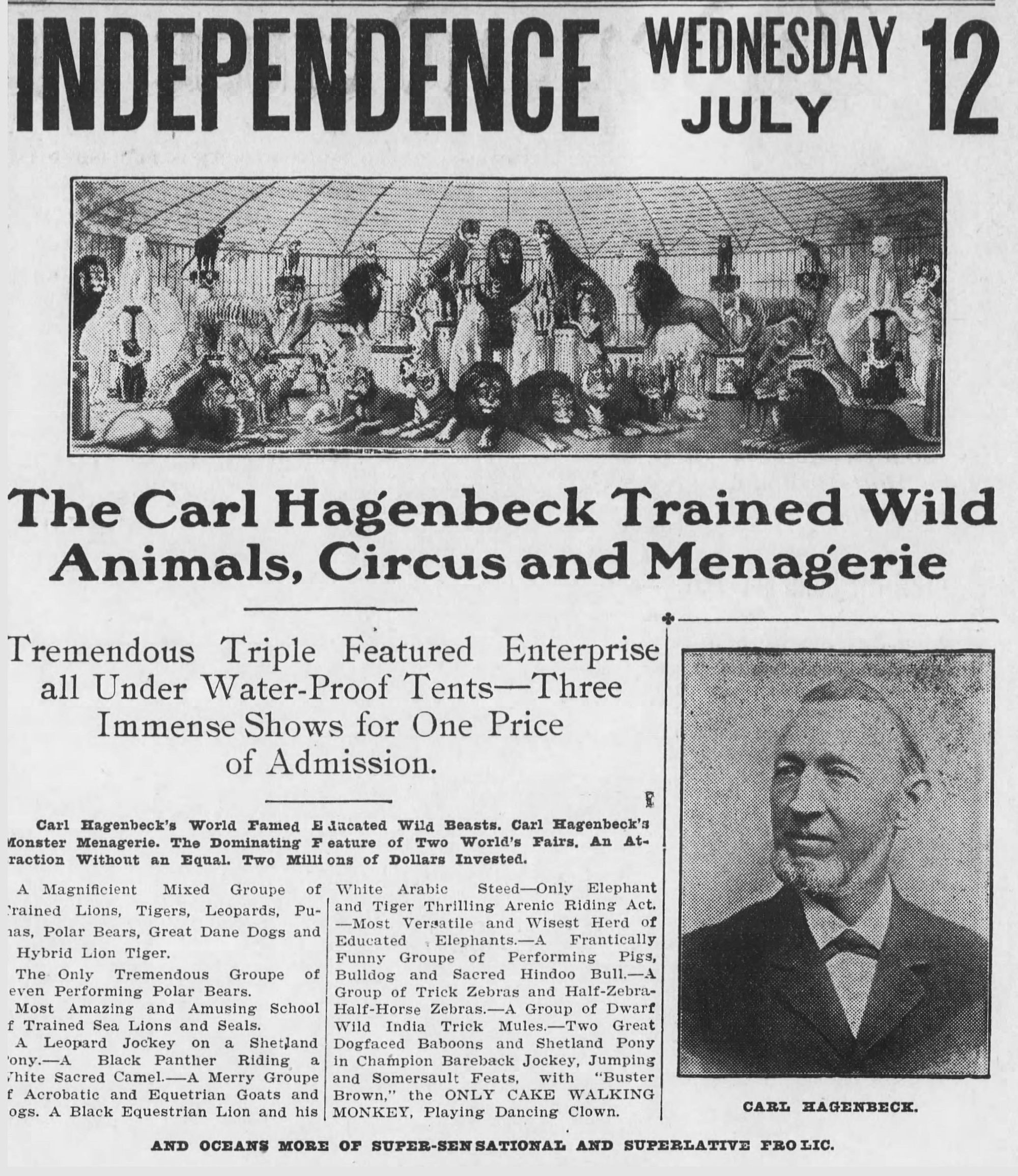
‘On entering the station at Suez we were greeted by some of our prospective pets, for in another train opposite we saw several elephants and giraffes; who pushed out their heads to welcome us. This, however, scarcely prepared us for what met our gaze when we reached the Suez Hotel. I shall never forget the sight which the courtyard presented. Elephants, giraffes, antelopes, and buffaloes were tethered to the palms; sixteen great ostriches were strolling about loose; and in addition there were no fewer than sixty large cages containing a rhinoceros, lions, panthers. Cheetahs, hyenas, jackals, civets, caracals, monkeys, and many kinds of birds. It was naturally no easy matter to transport this immense collection of wild beasts to Europe. The amount of food required was enormous. Besides the hay, bread, and sundry other vegetable foods which were needed for the elephants and other herbivores, we also took along with us about a hundred nanny-goats in order to provide the young giraffes and other baby animals with milk. When these goats were no longer able to supply us with milk they were slaughtered and given to the young carnivores to devour.
The journey to Alexandria, where we were to embark for Trieste, was by no means uneventful. On the way to the station the ostriches escaped, and were only recovered after considerable delay. Then one of the railway trucks caught fire, endangering the entire menagerie; and finally we were furnished for the last part of the journey with a drunken engine-driver who nearly burst his boiler. Moreover, the poor creatures were so closely packed together that it was impossible to feed them. We travelled all through the night, and arrived in Alexandria at 6 a.m. Here we joined forces with Migoletti's caravan. The whole of the next day was occupied in feeding and in general attendance upon my unfortunate beasts, which had suffered considerably from their long train journey.
However, at last they were all safely deposited on deck, and the passage to Trieste was accomplished without serious mishap. Our arrival at that port caused great excitement among the townsfolk. And small wonder! No such collection of wild beasts had ever before been seen in Europe. The united caravans of Cassanova and Migoletti included, apart from the smaller creatures, five elephants, fourteen giraffes, four Nubian buffaloes, a rhinoceros, twelve antelopes and gazelles, two wart-hogs, four aard-varks, and no fewer than sixty carnivores. Among the latter there were seven young lions, eight panthers and cheetahs, thirty hyenas, and many smaller representatives of the cat tribe. There were also twenty-six ostriches, of which sixteen were full-grown birds. One of these, a female, was the largest specimen I have ever seen. This hen could easily reach a cabbage which I placed eleven feet from the ground.
Pretty nearly the whole population of Trieste must have turned out to watch us unload. And whenever an elephant or a giraffe came sprawling across in the crane a roar of delight would go up from the multitude on shore. It was truly marvellous that we ever reached the railway station without an accident, for the crowd in the streets was enormous, and we had the greatest possible difficulty in making our way through. We travelled to Hamburg via Vienna, Dresden and Berlin, and as some of our possessions found new homes in the Zoological Gardens in each of those cities out numbers were greatly reduced by the time we finally arrived at our destination.'
Cassanova did not live to see the arrival of this record shipment in Europe. Broken by the dangers and privations he had undergone in collecting the animals, he died at Alexandria just before the departure for Trieste. Thus died one of Hagenbeck's greatest coadjutors, but there were others well qualified to step into his shoes. One of the best of these was Josef Menges, who from 1876 on has been the most trusted of the Hagenbeck "travelers." Before entering the employ of the Hamburg magnate he accompanied Gen. Gordon - "Chinese Gordon" - to the headwaters of the Nile, and saw almost all his companions succumb to fever. Another man who did splendid work for Hagenbeck was Essler, a Hungarian. Once, when he ventured into the African wilds, he was captured and held a prisoner for six years by King Theodore of Abyssinia, from whose clutches he was rescued by a British expedition. Soon after he joined forces with Cassanova, who was prospecting about for wild beasts to ship to Hagenbeck, and became one of the most valuable of the firm's employes. His specialty was capturing wild monkeys alive and to him was due the appearance in Europe of numerous extremely rare specimens of simians.
Cassanova was also responsible for securing for his employer the services of Kohn. an aged Bavarian daredevil, "dry as a. mummy, dug from a grave." Meeting Kohn, once in the wilds. when he was trading with the natives, Cassanova pointed out to him the pecuniary advantages of collecting animals for Hagenbeck. The talk impressed the old fellow so deeply that he turned up some time later in Europe with a troop of giraffes, which Hagenbeck promptly snapped up. Afterward. on four separate occasions, Kohn traveled into the very heart of Africa for the firm until he was finally murdered during the Mahdist uprising in the Soudan.
Then there was Grieger, who brought to Hagenbeck the first specimens of the so-called Prjevalsky wild horse ever seen in Europe. With one assistant he traveled into Turkestan, hundreds of miles from the nearest station on the Siberian Railway, and, while endeavoring to get the natives to help him in his quest, was exposed to a temperature of 50 degrees below zero, and could not kindle a fire owing to the difficulty of collecting fuel. When milder weather came Grieger organized a hunting party of natives who worked with such zeal and skill that they rounded up thirty of the coveted wild horses. This presented a new dilemma to Grieger. The order from his chief called for only six. Ought he to incur the additional expense and trouble of taking the others back with him?
Why not telegraph?" That occurred to Grieger just as it would to anybody else. To the nearest telegraph office and back was one thousand miles. The journey consumed three weeks. But he did it. And Hagenbeck. with characteristic enterprise, ordered his agent to bring the whole lot of horses to Hamburg. When the agent got back to camp he found that his industrious Mongolian helpers had increased the thirty horses to fifty-two. But he had had enough of trips to the telegraph office and started homeward with the entire outfit without consultation with his distant chief. After his arrival at Hamburg Grieger told Hagenbeck all about his arduous journey and Hagenbeck wrote of it thus:
‘Slowly the caravan wound its way over hill and dale, in rain and sunshine, in heat and cold. Anxiety for the safety of the captives was never absent. Many of them, as was inevitable, died on the journey in spite of all the care that could be exercised. And in other ways the journey was decidedly eventful. Before many days were passed the first incident occurred, namely, the escape of the camels owing to the carelessness of the attendants; and it was only with great trouble that their recapture could be effected. The attendants turned out to be, a bad set, for after a few weeks Grieger noticed that they were becoming discontented. At last a deputation approached him and announced the intention of the entire company to throw up the work and abandon the caravan, saying that the way was too long, the journey too difficult, and making many other similar excuses. The money, paid them in advance, they would as conscientious men return.
In vain did the traveller use all the arts of persuasion to induce the people to remain. In vain did he point out to them that the caravan would be totally lost if they were to desert him at this moment. At last the leaders of the mutiny professed themselves ready to remain, if a rise in salary were granted them. As soon as Grieger discovered that the whole affair was merely a vulgar attempt at extortion, he changed his tactics. Seizing his Kirghise whip, he promptly proceeded to distribute the augmentation of salary asked for, but in heavy blows instead of coin! This treatment was immediately successful, the mutiny calmed down, the ringleaders begged for pardon; and before long the caravan was jogging merrily along again, without the desertion of a single man.
In all, the transportation to Hamburg took eleven months. Out of the fifty-two wild horses which had started, twenty-eight arrived safely at their journey's end, where they were henceforth placed upon a diet of hulled oats, warm bran and carrots. Thus ends the story of how wild horses first came to Northern Europe.'
Some idea of the scope or the big business deals put through by Hagenbeck may be gained from the following:
In 1905 the German Government asked him whether he could secure 1,000 dromedaries, provide each with a suitable saddle, transport them from East Africa to German Southwest Africa, a distance of thousands of miles, and deliver the first shipment, to consist of between 800 and 400 beasts, within the short space of three months. ‘I can,' said Hagenbeck.
He set to work without losing a moment. His two sons, together with several of his most trusted veterans, including Josef Menges, were rushed to East Africa to secure the dromedaries there. In the meantime, Hagenbeck practically invented a suitable saddle, as none of the makes available was quite what was needed, and ordered one thousand of them from Hamburg saddlemakers. Next he chartered a steamer outright, built stalls in it for the beasts, filled it with suitable fodder, and sent it full steam ahead to East Africa. At the various ports to which the dromedaries secured by the Hagenbeck agents had been rushed the steamer picked up a total of 403 of the animals, and proceeded to Swakopmund in German Southwest Africa. On its arrival, well within the stipulated three months, only six of the beasts had perished in transit – an amazingly low number, which spoke volumes for the excellent system of the Hagenbeck organization. The other shipments followed in due course. The German Government was so eminently satisfied with the handling of this remarkable order by Hagenbeck and the quality of the ‘goods' delivered that it promptly ordered another thousand, as per sample.
Hagenbeck was indefatigable not only in buying and selling animals but in training them, developing new methods of caring for them and looking out for every conceivable kind of novelty in the animal kingdom. One of his last achievements before his death was the creation of a model ostrich farm, where he obtained very successful results. Emperor William of Germany paid a visit to this unique place and personally inspected the ostriches, big and little, which inhabited it.

On the 18th May 1891, Herr Carl Hagenbeck gave a show of trained wild beasts - lions, tigers, cheetahs, leopards, bears and boarhounds (Great Danes) - at the Crystal Palace in London. There was also a Carl Hagenbeck Circus in the USA, but from 1907 (when Hagenbeck opened his Tierpark) the Indiana-based circus was owned and operated by Ben E Wallace as the Hagenbeck-Wallace Circus with animals trained the Hagenbeck way. Hagenbeck sued over the use of his name, but lost the case. The Hagenbeck-Wallace circus closed in 1938.
Several big cat hybrids were bred, photographed and documented by Hagenbeck in the early 1900s at the Tierpark. He kept records on the success of the pairing, whether or not offspring were produced and survived and on the hybrids' appearance and fertility.
The Croydon Chronicle and East Surrey Advertiser, 19th December 1903, shows that Hagenbeck's interests did not stop with big cat hybrids. "Scientific Cross-breedings. Carl Hagenbeck, of Hamburg, the well-known wild animal dealer, has bred a hybrid of the lion and the tiger. which carries marks of both parents, and, though tawny, is faintly barred like the tiger. A new pheasant has also been produced by him through crossing Central Asian with European birds. It is larger, prettier, and stronger in wing than our partridge. The Duke of Bedford and Lord Rothschild have acquired some of his broods. New varieties of deer have also been obtained from the Persian fallow and ordinary European deer. Moreover, he is trying to introduce the zebrule, or hybrid horse and zebra into the German Army in place of mules. We know that the zebrules are being tried in the Indian Army. His investigations into breeding hybrids of horses, ponies and zebras corresponded with the findings of James Cossar Ewart regarding the latter's zebra hybrids. Hagenbeck's experiments helped scientists to understand the relatedness of certain species and to dispel various myths surrounding inheritance.
His most successful big cat hybrids seem to have been his ligers; these were described in a letter to Cossar Ewart in December 1900 and they appear to have been used in performances. Another successful and repeated pairing was that of a puma to a leopardess; a pairing suggested to him by a small (unidentified) English menagerie (this was possibly Lord Rothschild). Records from 1900 describe three sets of twins though only one hybrid survived for any length of time and this showed a tendency towards miniaturisation, being about half the size of the parents. Hagenbeck described the puma/leopard mixes as not particularly noteworthy. Hagenbeck also paired a leopard with a lioness, resulting in live leopon offspring though none survived to maturity. His pairing of a Bengal tiger with a leopardess in 1900, described in a letter to Cossar Ewart, resulted in stillborn offspring that had both spots and stripes. The mating was apparently not repeated since no other information seems to have been reported.
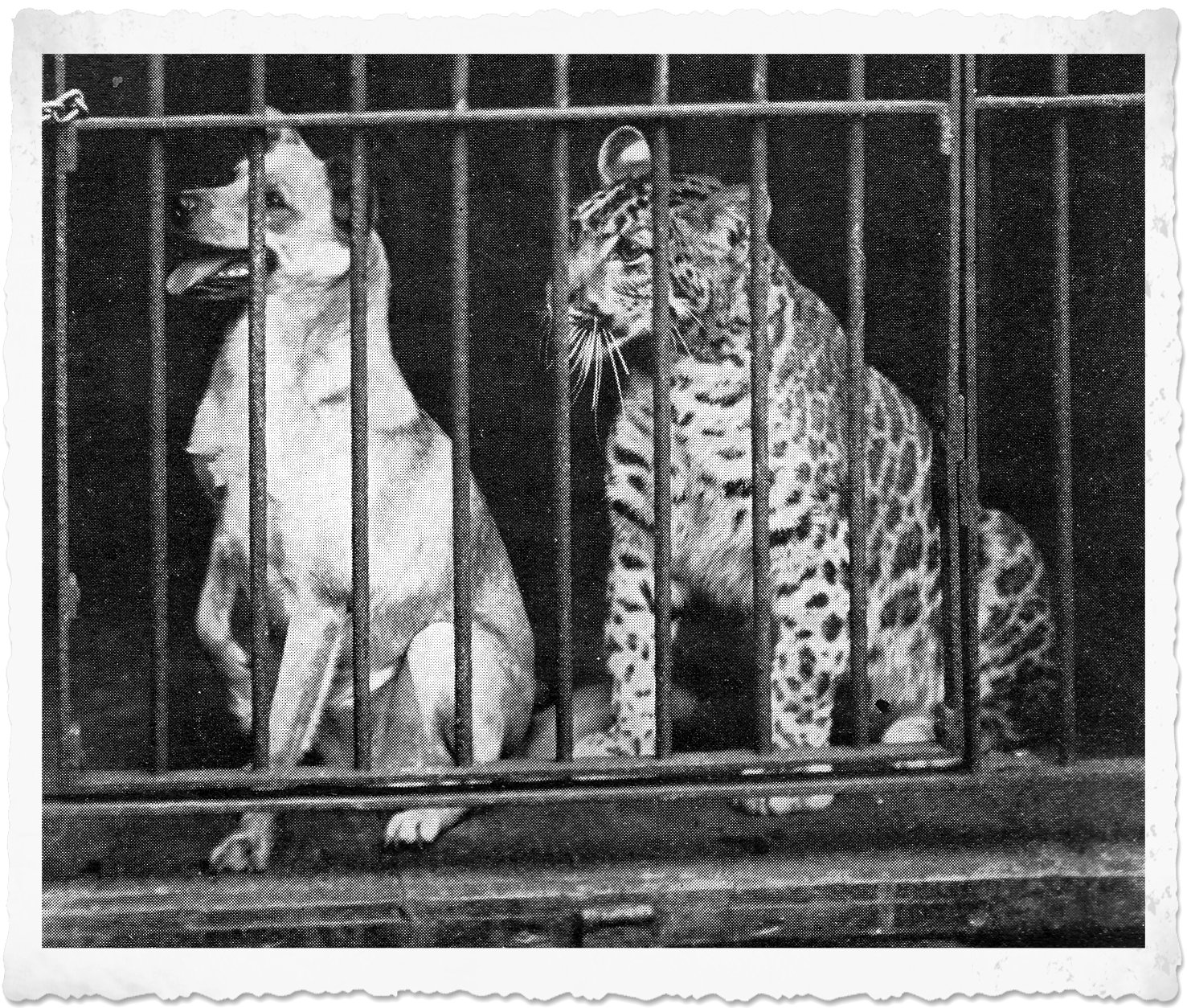
To ensure their survival, (relative) tameness and to allow displays of mixed species, big cat cubs were reared by canine foster mothers. Below is an engraving from the 1870s showing a terrier bitch with her full-grown foster child.
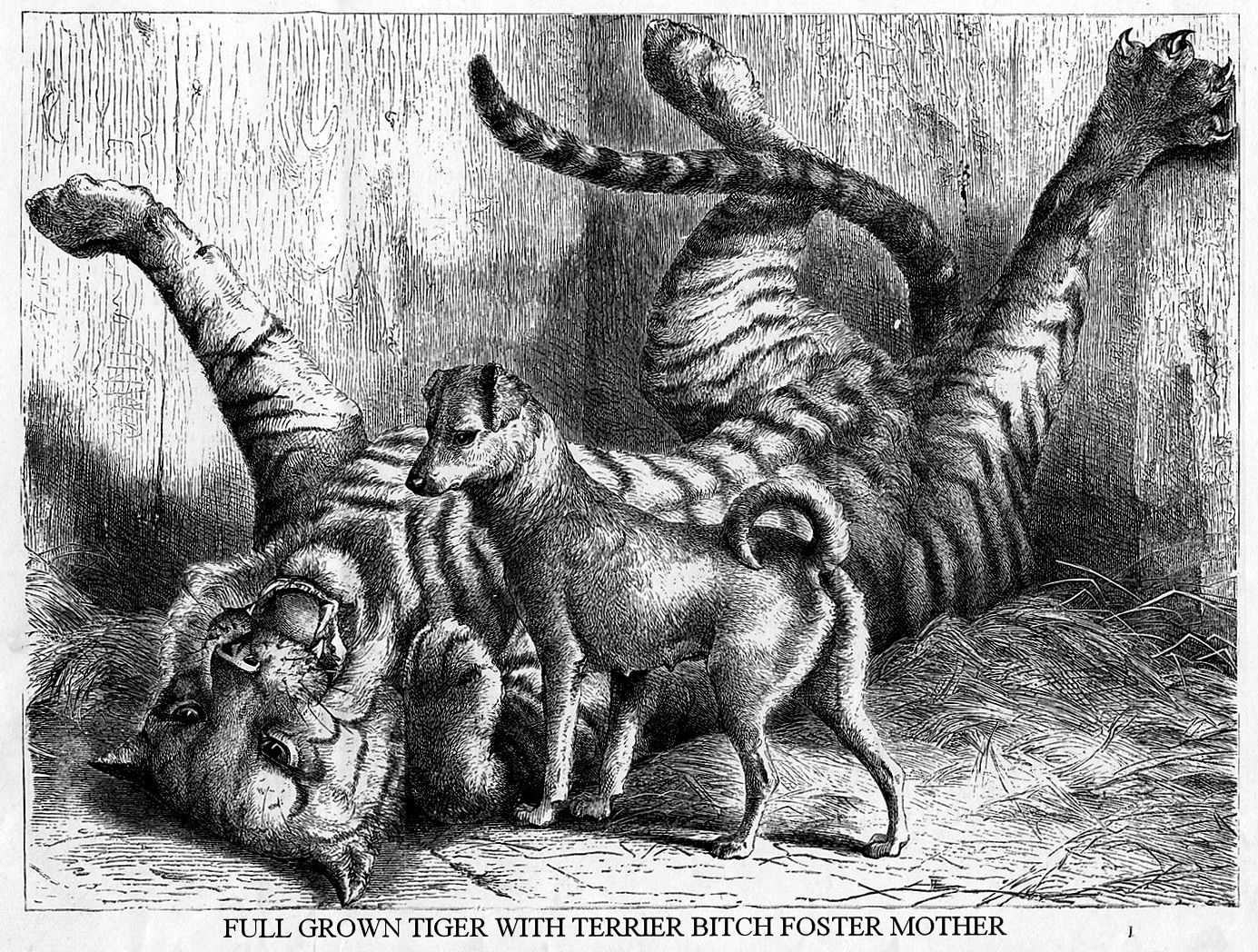
HAGENBACK PRODUCES NEW WILD BEASTS. Wood County Reporter (Grand Rapids, Wisconsin), 19th March 1903, pg 2.
Recent important scientific disclosures point to the fact that the standard natural histories will need soon to undergo an overhauling. What zoologists the world over have always contended could never be done, Carl Hagenback, the celebrated German animal trainer, has finally succeeded in accomplishing. In the animal kingdom Mr. Hagenback has brought about a veritable marvel. Producing a species of brand new wild animal. At the same time demonstrating the possibility of breeding lion and tiger hybrids with the same degree of success as the offspring of any other family known to the animal kingdom are bred. Naturalists have long been agreed on one point. That no success would ever attend any such experiments. This fallacy the great animal dealer has, however, altogether set aside. Having obtained some extraordinary specimens of this monster creature. A true cross between the lion and the tiger. A strange beast having many of the characteristics of both parent stock. The animals which Mr. Hagenback has produced are the only ones of their kind in existence. That they will shortly be the parents of an entirely new and altogether unknown species of the animal kingdom he has every reason to anticipate as they have attained an age sufficiently mature to warrant their being classed as a family by themselves.
The new creature is of enormous size. Being larger than either the tiger or lion. And it is generally spoken of as a monster. Although this refers more to its mammoth proportions than to its disposition or animal instincts. For the lion and tiger hybrid is said to possess a remarkably mild and loving nature. Showing greater fondness for human companionship and taking greater delight in being fondled and made much of than is characteristic of wild animals in general. From the nose to the tip of the tail the lion-tiger measures ten feet two inches. Which is a greater length than that of a full-grown lion. When it stands erect its height across the withers is forty-five inches. Its correct weight being 467 pounds. The animal shows slightly the stripes of the tiger, without being furnished with a mane like the tiger. The lion begins to grow his mane when about three years old. Many of Mr. Hagenback's new species of animals have gotten beyond that in years. but none display any signs of a mane. And he has no idea that they will ever do so.
Mr Hagenback is justly proud of this new arrival to the animal kingdom, and his intentions are that the children of these hybrid parents shall continue to preserve their type as distinct in every feature except color, Which naturally may be expected to vary in different members, as is the case throughout the numerous classes of the great animal kingdom. Two of Mr. Hagenback's baby hybrids made friends at once with a small terrier. The dog mother nursing and caring for the young things with as great care as she would take of her own puppies. They would lie across the terrier in the same manner they might have stretched themselves over the body of their own mother. And while the lion-tiger hybrid babies were being brought up on the bottle it was a common thing for them to share the dog mother's milk with her own children. None of the young things seeming to think that family differences should give rise to any distinction whatever. Curiously enough, the males of this new species have shown the tiger markings more distinctly than those of the lion, while the females have developed greater marked characteristics of the king of the wild beasts.
SOME BRAND NEW ANIMALS. REMARKABLE EXPERIMENTS AT A HAMBURG WILD BEAST FARM. Illustrated Mail, 1903
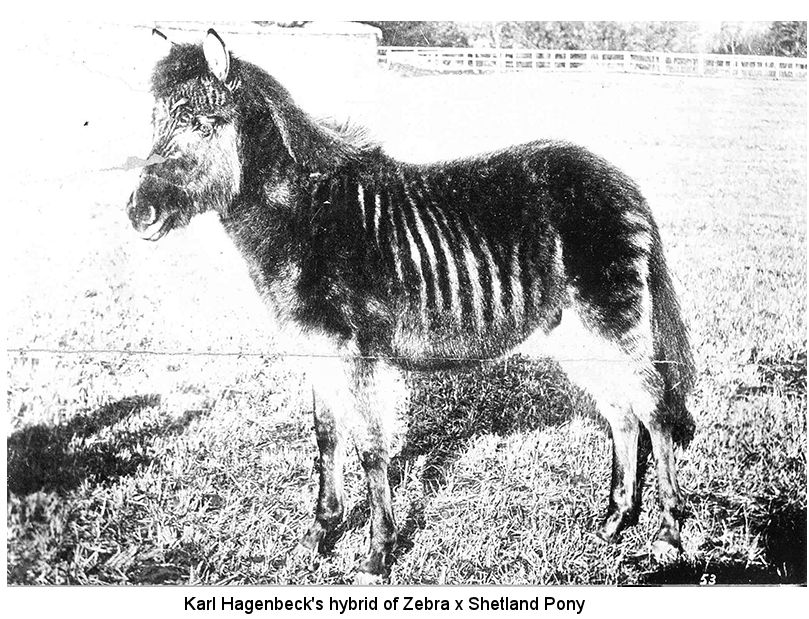
Mr. Carl Hagenbeck, the famous animal dealer of Hamburg, has produced some entirely new animals. For instance he has secured an entirely new breed of pheasants by crossing pheasants from Central Asia wit European pheasants, while he has also obtained some new varieties of deer and mules. The most interesting of these "productions" probably is the cross between the zebra and a horse. He has a number of these at his depot in Hamburg, and when in that city recently a representative of the "Illustrated Mail" was taken for a drive behind two of these strange "horses." The characteristic feature of this animal is that it has a horse's head and a zebra's body. If anything it is a little larger than the average zebra, though the stripes are not so pronounced.
For six years now Mr. Hagenbeck has given serious consideration to this subject. It should be stated at once that his one aim in conducting these experiments has been to obtain a stronger and better animals – that is to say, better blood. He is carrying out the zebra crosses at the advice of Professor Hewitt [Ewart], of Edinburgh, who contended several years ago that an improved "horse" could be secured by crossing the pretty striped African zebra with our domestic horse. Zebras, however, are expensive, and have to be handles with care. This is the reason why the professor sold the greater part of his tock to Mr. Hagenbeck, on the understanding that he continued the experiments. The results which have been obtained in Hamburg are certainly gratifying. The new beast, though not quite so large as the common horse, is yet bigger than the average mule, and, as Mr. Hagenbeck remarked, "is not at all as tricky as the ordinary mule generally is."
Indeed, the great dealer is very enthusiastic about the final results. In his stables at the present time ther are no less than six of these new creatures. Some of them have been satisfactorily been broken to harness.
"The first successful experiment I made was with a leopard and a puma," said Mr. Hagenbeck recently, "And the only living animal of the litter I sold some time ago to the Berlin Zoological Garden, where it is still in the collection."
The most interesting cross-breds at the depot are those of lions and tigers. One of these strange animals has been taught to do some stage tricks, and is now performing with others in one of Mr. Hagenbeck's groups of trained animals. He is three years old, and a fine creature. He weighs nearly five hundredweight, measures ten feet from the tip of his tail to the tip of his noses, and stand four feet high up to the top of his shoulders. The peculiarity of this beast is that it has a tiger's body and a lion's head. His father was a Senegal lion and his mother a Bengal tigress. A cross-bred which will particularly appeal to sportsmen is the new pheasant. It has been obtained by crossing pheasants from Central Asia with European pheasants. The result is a larger bird, stronger on the wing, and more prettily marked. The Asiatic pheasant very much resembles an English pheasant in appearance. It is somewhat larger, however, and very fast on the wing. Mr. Hagenbeck has succeeded in securing several broods of these new pheasants. The first of these were obtained in the April of last year. All of them have been purchased, the Duke of Bedford and Lord Rothschild taking the larger portion. He had several brooks again at the beginning of last June. The birds are quite healthy and doing well.
"I am also endeavouring to obtain a new variety of sheep by crossing the giant wild sheet of Central Asia wit our domestic animal" (continued Mr. Hagenbeck), "I am now making extensive arrangement in my park at Stellingen to carry out this experiment. I am doing this on the advice of Professor Kuhn, of the Royal German Agricultural Institution, The professor is confident that farmers and all agricultural people will welcome and improved sheep. Indeed, I have already received two letters from well-known breeders in England asking for details of this cross. I mean to continue my experiments in this direction."
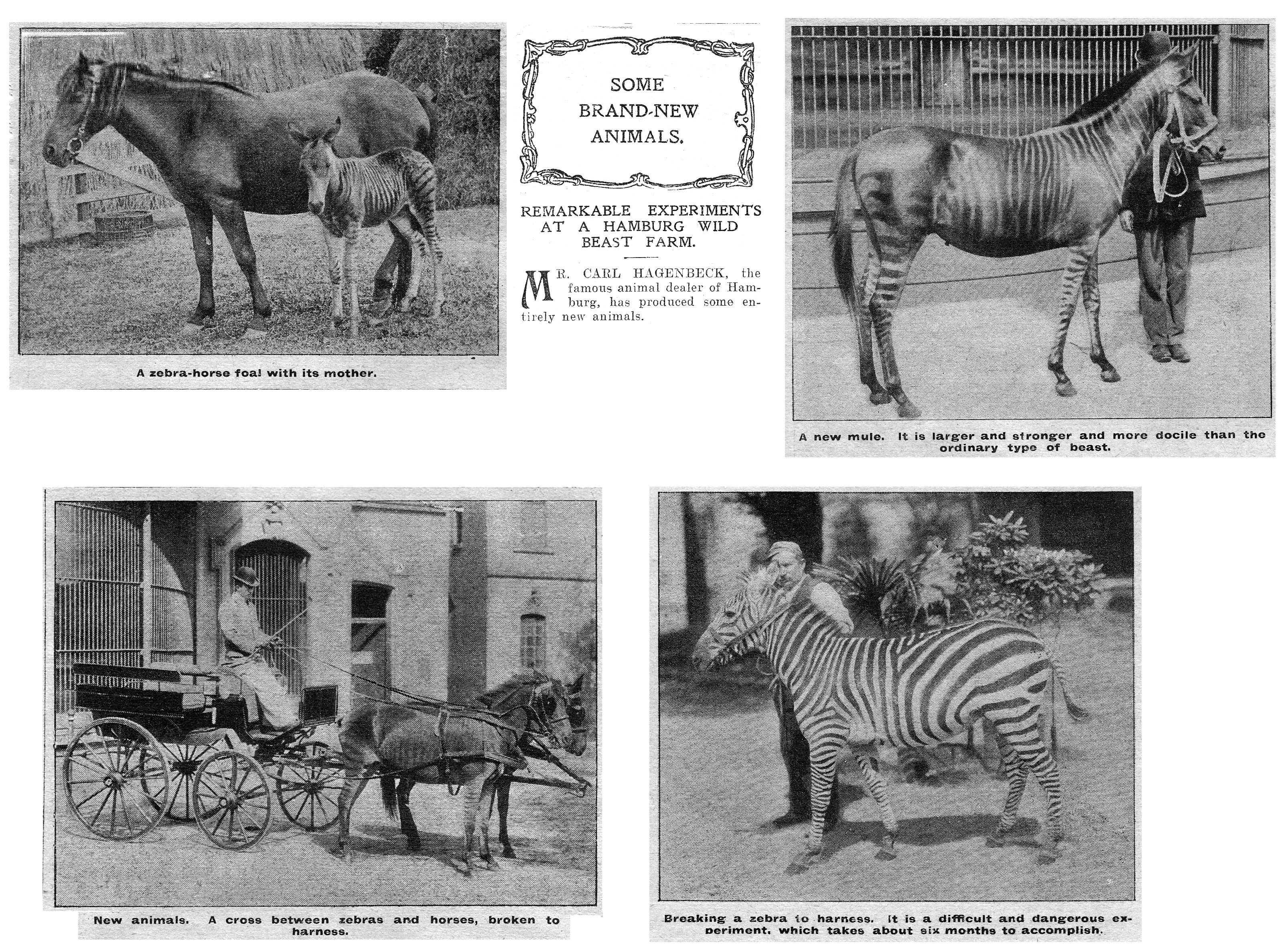
REMARKABLE HYBRID ANIMALS - The Saint Paul Globe (10th May, 1903)
That entirely new species of animals may be created is demonstrated by the latest achievements of the worlds greatest animal hunter, Carl Hagenbeck. After a lifetime of study he has brought into existence a monster creature that has no place in natural history, yet is the offspring of a Senegal lion and a Bengal tiger. On his animal ranch, near Hamburg, Germany, Hagenbeck has for some time past been devoting himself to the creating of new species of animals and birds. He has sequred an entirely new breed of pheasants by crossing pheasants from Central Asia with European birds. He has obtained new varieties of deer and indies and wonderful crosses between the zebra. and the horse.
A strange creature, the offspring of a leopard and a puma, is now in the Berlin Zoological garden, but of, all these the nameless monster now in his gardens at Stellingen is the most wonderful. From the time Hagenbeck began hunting wild beasts in India and Africa he wondered, what sort of beast the two fiercest animals on earth would produce if they could be made to breed together. In order to try the experiment, several years, ago he secured a splendid specimen of the Senegal lion and a monster Bengal tigress. Eventually the new monster, which is with the Hagenbeck trained animal show, was born. It is now larger than either the, tiger or the lion, and does not seem to have reached its full growth. From the nose to the tip of the tail the lion-tiger measures 10 feet 2 inches, which is a greater length than that of a full-grown lion. When it stands on all fours its height to the shoulders is 4 feet. Its weight is 467 pounds. The body of the animal shows the stripes of the tiger, but its head is that of a huge lion, except that it has no name. Yet in the face of its mammoth proportions and fierce aspect, the disposition and animal instincts of the "beast are more like those of a dog than either of the two fierce wild animals of which it is the offspring. Even to other animals it shows a remarkably mild nature. It possesses a great fondness for human companionship, and takes great delight in being fondled and made much of that is characteristic of wild animals in general. But this is only one, perhaps the greatest, of the marvels which the famous naturalist had brought about.
His gardens at Stellingen are now filled with birds and beasts which are the only ones of their kind in the world, and that these creatures themselves will shortly breed new and altogether unknown species of the animal kingdom is Hagenbeck's conclusion. It is his desire that the progeny of these hybrid parents shall continue to preserve their types as distinctly as is the case throughout the numerous classes of animal species, and it [is] his prediction that in some way or other they will ultimately be put to the use of man. Probably the furthest developed of the new species of animals he is creating is the cross between the zebra and the horse. A number of these are at his depot in Hamburg, and it is not an uncommon sight to see him taking a drive behind two of these strange ‘horses.' The characteristic of these animals is that they possess the zebra's body and the horse's head, and are as large as mules. The aim has been to obtain a stronger and better blood than that possessed by the existing Equine breeds. At present Hagenbeck has six zebra-horses broken to harness. He has found them possessed of greater endurance and strength than horses of their weight, and seemingly possessed of greater intelligence.
The new species of pheasant is appealing particularly to sportsmen, and may displace the European pheasants now' common to in European preserves. It is a larger, gamier bird, much stronger on the wing, more prettily marked, and not nearly as ‘chickenish' as the pheasant now pursued by the sportsmen. The chief characteristic of the Arctic pheasant, with which the European has been successfully crossed, is its marvelous swiftness of wing, its endurance and it fineness of flavor. The Duke of Bedford and Lord Rothschild have already planted several of Hagenbeck's brood on their preserves, and as fast as the new species can be raised others will follow their example.
Perhaps the experiments of the greatest interest to the country at large are those on which Hagenbeck is now engaged in his endeavor to secure a new variety of sheep by crossing the giant wild sheep of Central Asia with the domestic animal. In his work Hagenbeck is aided by Prof. Kuhn, of the Royal German Agricultural institution, and thus far the results have been such as promise success. The domestic sheep of today are extremely delicate, undersized and in many respects so undesirable that thousands of farmers are giving up breeding them. It is anticipated that the new species will retain enough of its Asiatic mother characteristics to make it stronger, heavier, and at the same time of better flavour than the present domesticated animals. The wild sheep of Asia make an extremely fine meat.
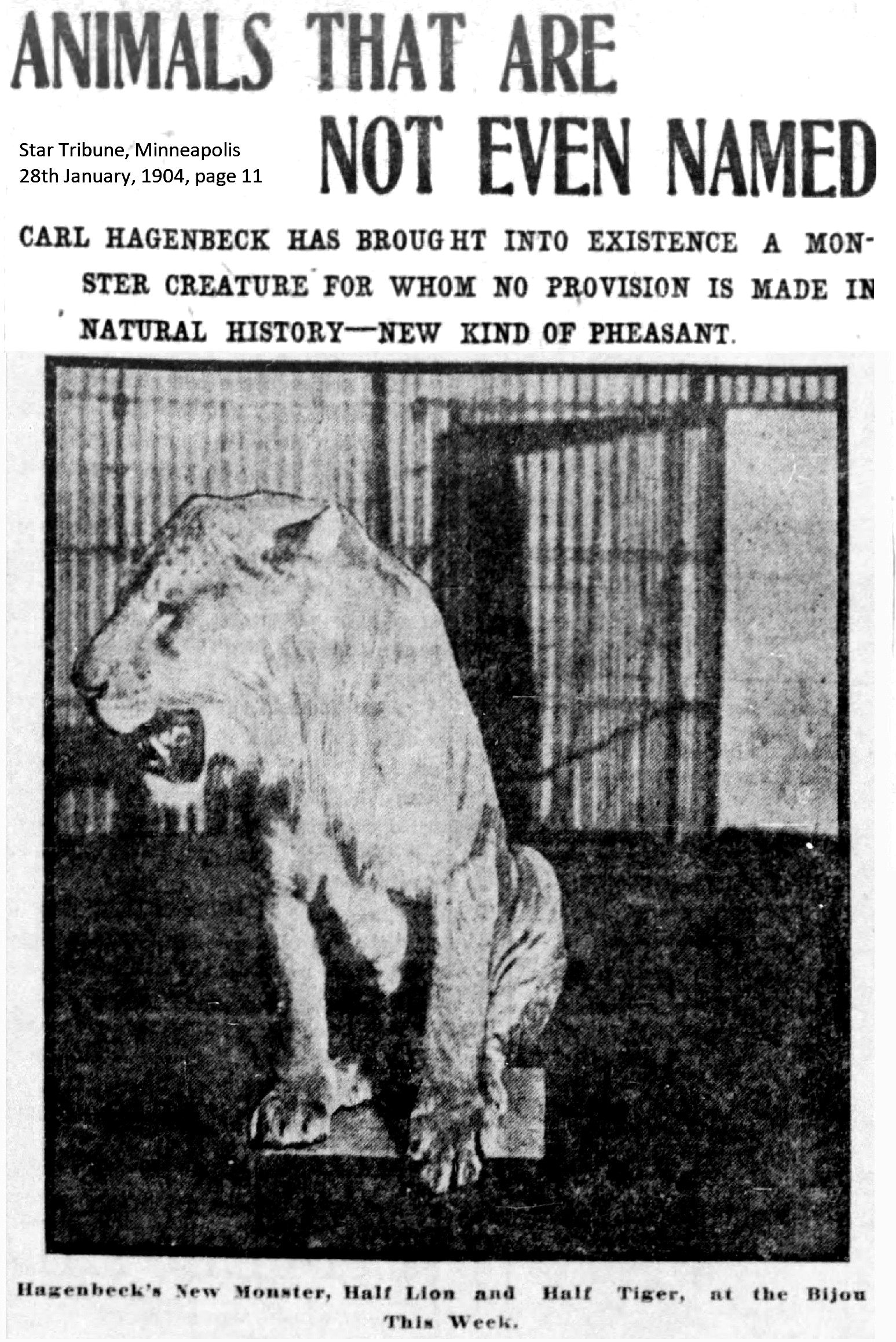
Excerpts from ANIMALS AND MEN Adventures and Experiences, by Carl Hagenbeck, 1909
Since, as I have already said, love affairs between lions, tigers and other cat species occur without human intervention, it is obvious to attempt to cross. I have bred cubs from lions and Bengal tigers several times and still have a five and a half year old male hybrid, and male and a female hybrids both three and a half years old. The father was a small Somali lion and the mother was a small Bengal tiger. However, the products resulting from this misalliance are significantly larger than the parents. One male hybrid is so large and has such a colossal physique that he weighs as much as the two parents combined. The hybrids are beautiful: large, extremely powerful, very faintly striped animals with a strong head. Anyone who sees them first thinks they are looking into a distorting mirror and at first does not know whether they are looking at lions or tigers. The animals are extraordinarily tame and have a mild temperament, but according to previous observations they are unfortunately unable to breed.
A cross between a leopard and puma was made at my instigation in a small English menagerie. Several young were obtained, but all perished except one, which was not remarkable in size or appearance. Also, something had developed between a Bengal tiger and a female leopard in the garden, but the cub was born too early and was not viable. I also know of a happy union between a lion and a female leopard, which occurred in a small German menagerie among animals that came from my collection. The leopardess gave birth three times, but unfortunately she turned out to be a monster without any maternal feeling, because she immediately ate her cubs. On one occasion the owner managed to take the cubs away from the uncaring mother, but unfortunately he couldn't rear them and he threw away their bodies instead of conserving them in alcohol for science.
Very interesting hybrids were bred by Mr. Nill in the zoological garden in Stuttgart, which is unfortunately now defunct, namely hybrids from brown bears and polar bears. Recently I saw some of these animals, which are now in the London Zoological Gardens. They are very large and heavy, though no larger than the parents. One is a very comical fellow, that is to say a piebald, his fur being half grey-brown and half white. Like the lansquenet mercenaries of old, he appears to have a mismatched doublet and mismatched trouser legs.
Siberian Maral deer, Cervus eustephanus, . . . crossed with our red deer make excellent game. The first breeding attempts with this game were made by the oft mentioned Falz-Fein, who crossed Siberian stags with the common red deer and achieved offspring that produced four-pointers in the first year and ten-pointers in the second year. The Siberian Maral deer is almost the same as the Wapiti in terms of size, so the hybrid offspring is valuable for hunting, because the animal grows much larger than the red deer and also grows beautiful antlers.
Wonderful results have been achieved by crossing Mongolian pheasants (Phasianus mongolicus) with the common English pheasant, because the hybrids are more than thirty percent heavier than the English pheasants bred to date. If one considers that in England hundreds of thousands of pheasants are shot every year, one can almost calculate what an enormous benefit this crossbreeding has brought and continues to bring to English pheasant breeding.
At this point we should also mention the hybrids between zebras and horses, as well as horses and donkeys, the zebroids and mules, which deserve far more attention than is given to them in Germany. Professor Ewart in Edinburgh achieved very good results in the production of zebroids. At that time, I bought all the zebroids bred by the professor. Two of the animals were acquired by the English government for the mountain artillery in India and are said to have performed very well; two others, a stallion and a gelding, have been in use by myself for several years. The animals are very efficient and also have just as much endurance as mules, which should become more naturalized in Germany. Americans more greatly appreciate mule breeding because, according to the statistics I saw a few years ago, over a quarter of a million mules are raised in the United States each year.
What happened to Hagenbeck's Zoo and his famous hybrids? The Dundee Courier, 27th September, 1920, tells us of its fate during the Great War. BREAK UP OF A FAMOUS ZOO. Animals Sacrificed As Food for Others. Among the many tragedies resulting from the war perhaps one of the most striking from the popular point of view is that of the decay of Hagenbeck's Zoo, Hamburg, which now being broken up and sold. . . . Slowly but surely the spectre of starvation has stalked among them, until sorry remnant of this once-famous collection remains. . . . A number of valuable animals' have perished, including some rare and almost extinct specimens. Among the latter were several strange hybrids, obtained by crossing such animals as lions and leopards. What animals remain are in an appalling state of neglect, many of their keepers having fallen in the war. Animals ate their own young, their mates, and weaker members of their packs, while others were fed to the carnivores. However it was rebuilt. Though destroyed during air-raids in WWII, it was again rebuilt and remains a privately run zoo.
Textual content is licensed under the GFDL.
|
BACK TO HYBRID & MUTANT BIG CATS INDEX |